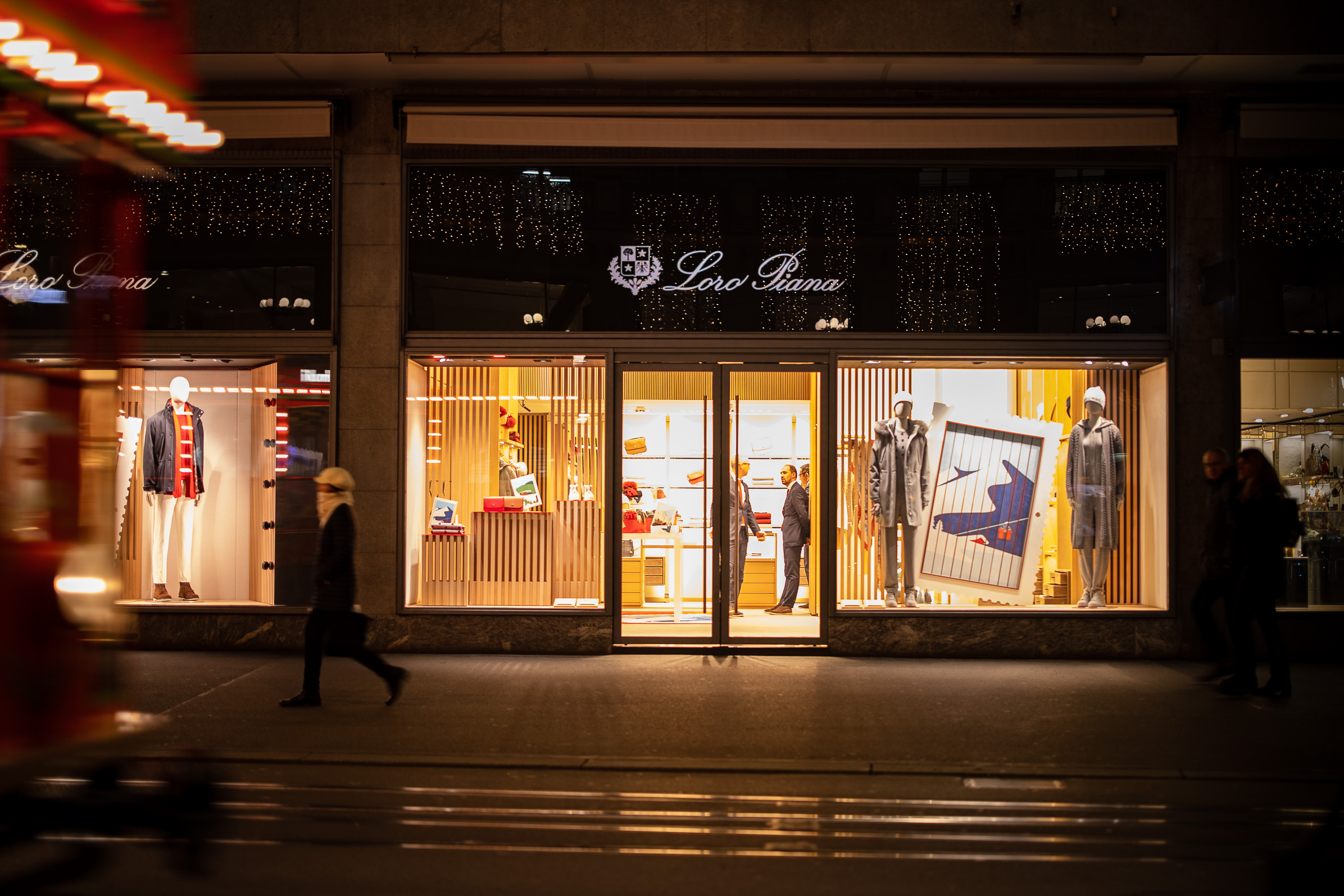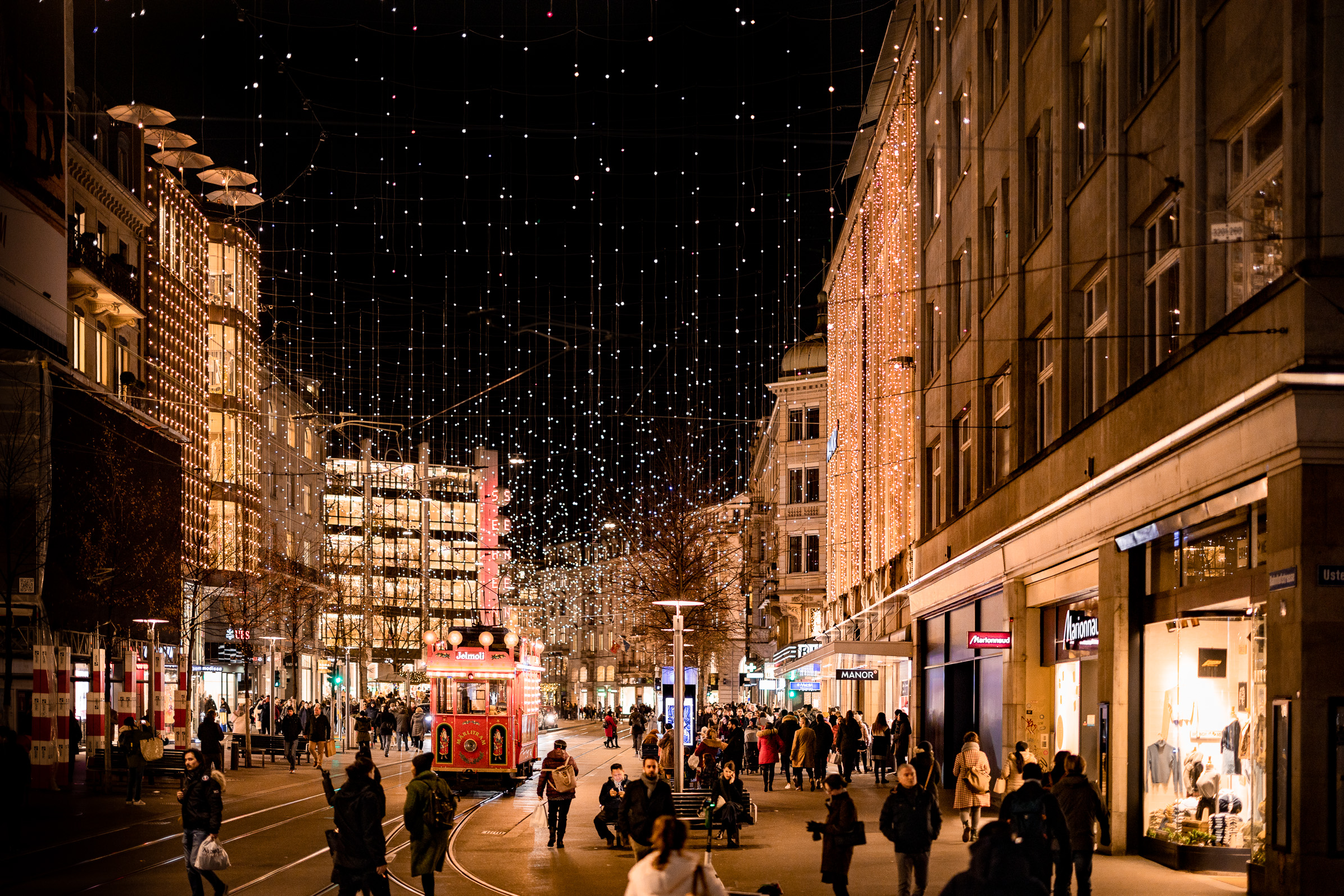Harrods Knightsbridge – wie der stationäre Handel Zukunft hat
von Aaron Fuchs und Michel Meliopoulos
Die Zürcher Bahnhofstrasse in der Vorweihnachtszeit
Die prachtvolle Weihnachtsbeleuchtung an der Zürcher Bahnhofstrasse sagt viel über die kommerzielle Bedeutung der Einkaufsmeile aus. An wenigen Orten auf der Welt ist der Flächenumsatz im stationären Handel grösser als hier. Doch die traditionellen Warenhäuser stehen unter Druck: Manor, die grösste Schweizer Warenhauskette, kündigte im September 2019 an, dass sie Ende Januar 2020 nach 35 Jahren Geschäftsbetrieb ihr Flaggschiff an der Bahnhofstrasse schliessen wird. Bereits im Sommer 2019 gab die grösste Schweizer Detailhändlerin, die Migros-Genossenschaft, bekannt, sich von Globus trennen zu wollen. Die offiziellen Gründe: Steigende Fixkosten, steigender Preisdruck und natürlich die wachsende Konkurrenz durch den Online-Handel. Folgt man dem Grundkanon der Presse, dann ist das stationäre Warenhaus ein Auslaufmodell aus dem letzten Jahrtausend.
Aber ist das wirklich so? Schliesslich gibt es auch stationäre Warenhäuser, die trotz widrigem Marktumfeld sehr erfolgreich sind. Ein gutes Beispiel dafür ist das berühmte Londoner Kaufhaus Harrods. Im Vereinigten Königreich bewegen sich die stationären Händler – vor allem jene im Bekleidungssektor – im derzeit schwierigsten Marktumfeld Westeuropas. Allein in der ersten Hälfte des Jahres 2019 kam es zu einem Nettorückgang von 1’235 Läden an den 500 wichtigsten Hauptstrassen des Inselreichs. Besonders stark betroffen sind Warenhäuser und Bekleidungsgeschäfte. Wie es Harrods auch unter diesen anspruchsvollen Bedingungen gelingt, erfolgreich zu bleiben, darüber haben wir uns mit Gregory Blomley unterhalten. Als Brand Store Manager des italienischen Modehauses Loro Piana im Harrods kann er die Entwicklungen an der Schnittstelle Leistung-Kundschaft jeden Tag aus der Nähe mitverfolgen. Das Gespräch fand auf Englisch statt.

Brand Store von Loro Piana
Greg, why do people shop at Harrods?
Harrods prides itself on the excellence of service provided to all of its clients along with a vast selection of products. The store’s motto is ‚Omnia Omnibus Ubique‘ or ‚All Things for All People Everywhere‘. We are also the 3rd most visited tourist attraction in London so balance the meeting of our high net worth clients’ needs along with those of our visitors who view the store as a tourist attraction to be experienced. In order for Harrods to set itself apart from its competition from other department stores and the brands‘ own boutiques, it is constantly looking for new ways to engage and amaze its clients whilst also offering them exclusive products and personalisation. Harrods also offers an incredibly generous rewards scheme to all of its clients, regardless of their spend in store.
One of the big challenges of today’s department stores is e-commerce. You have worked in different departments within Harrods. How is Harrods responding to the increasing pressure from the online channel?
The main challenge faced by Department stores online is that their biggest competitors are the brands direct websites themselves which often will have the full collections with much better availability of stock. Harrods however looks to combat this with its content in that it will offer style guiding, editorials and comparisons across brands of certain themes and trends allowing comparative shopping for the client. Harrods has recently undergone a full re-platforming in order to remain competitive in this area while also negotiating with brands for exclusive product. However, Harrods has the benefit of being able to terminate contracts with under-performing brands or those that have fallen out of favour with our clients while also being able to quickly adopt new and up and coming brands, which is of huge benefit in a trend driven industry.
Do online presence/distribution and luxury brands go together? It seems that there is some real tension between the two: Luxury goods have a particular touch and feel (e.g. the fine texture of a cashmere product) that is best experienced live. Isn’t it dangerous to push the luxury world too much into the e-commerce space without providing an adequate point of sale where customers can actually experience the product?
While I agree with you around the sensations of our in-store experience, the online presence of Luxury retail is still incredibly important to the client, especially with regards to researching their purchase ahead of their visit to the store. Our clients are cash rich and time poor, so while they still want the sense of ceremony that comes with a high value purchase, they also want to be able to know we will have availability of that product (especially important in the watch industry where pieces can be made in very limited numbers) and to better understand the intricacies of it before discussing it with a Sales Associate.
With regards to the fashion industry, one of the greatest developments in recent years is ’see now buy now‘, where availability of catwalk collections is available in stores immediately after the brands fashion show in London, Milan etc. This was originally adopted by Tom Ford several seasons ago to great effect- However, it put pressure on supply chains and brought with it a certain level of secrecy ahead of the shows. In these ways luxury takes a different approach to online, regarding it less as a means of direct selling as other e-commerce businesses and industries might.
Globus, a large department store chain in Switzerland, has announced a different store concept in 2017. In every location, no matter how small, the entire Globus range of goods should be available via ordering. Clients can shop in the so called “digital showroom” (a concept presented by Tommy Hilfiger in early 2015). What do you think about this store concept?
Globus is not a brand I am familiar with. However, looking at their price point and breadth of offer I would anticipate incorporating a ‚digital showroom‘ model in store to be of huge benefit. However, this would depend on their lead time for delivery and availability. Many retailers in the UK (with multiple stores and warehouse facilities) offer similar services with guaranteed next day delivery which can put a company’s supply chain under pressure if not managed correctly and can also lead to poor sell through in the ordering stores stock (much better to have a sales team who can sell what they have rather than ship additional stock to store). With regards to availability, many store stock systems update every 24 hours (usually overnight after trading). If the systems between stores are not fully live, it could have the potential to lead to multiple orders for the same item and ultimately customer dissatisfaction.
You’ve mentioned some of the challenges of the Globus concept that will have to be managed to deliver a compelling customer experience. However, we are also keen to hear what you think should be the role of stationary stores in the future. Is the department store of the future an experience location, like Disneyland or the Porsche Museum? In our view, the experience should revolve not so much around entertainment a la Disneyland, but rather around experiencing a product’s performance in a way that effectively reveals the value it can add to the customers‘ lives.
The recent, and successful, evolution of Harrods has been away from experience in the sense of Disneyland (activities and attractions) as a retail space should always keep an eye on its primary goal, to sell. It has moved much more towards experience in the sense of the environment of the store (high quality shop fits, historical features etc) and the service experience (unrivaled anywhere in the world). This has led to department closures in previous years of such areas as Pet Kingdom (while popular with visitors to see all of the animals, it was not sufficiently profitable). Some view this as department stores moving towards a similar model to that of a Shopping Mall, however, through maintaining a strong brand identity, this can and is being avoided.
Today, the brand Harrods is closely linked with the department store in Knightsbridge. In your view, is it possible that Harrods will be present on the market without the department store?
I truly hope not! All of the defining characteristics and defining features for the Harrods brand that we have touched on are all intrinsically tied to the site in Knightsbridge. Harrods is not, and in my opinion never should be, a solely online retailer. It would best benefit from a stronger online presence, but always linking back to the store. Knightsbridge is Harrods.
What is the trend or development that occupies you the most at the moment?
Evolution would be the key factor in all of my strategic thinking of late. How do I evolve my business to grow and succeed in the future? My company and the brand itself is one very much reliant on its history and heritage, that is why we are the best at what we do. But how do we ensure these values, product offerings and levels of service appeal to a new, younger generation?
Über Harrods
Harrods wurde 1834 als Tee- und Lebensmittelgeschäft im Osten Londons gegründet, bevor es 1901 an seine heutige Adresse in Knightsbridge zog. Der aktuelle Besitzer Qatari Holdings hat das Geschäft 2010 für £1.5 Milliarden vom früheren Besitzer Mohammed Al-Fayed übernommen. Das heutige Gebäude hat mehr als 10’000 Quadratmeter und wird durchschnittlich von 100’000 Gästen pro Tag besucht; in der Weihnachtszeit kann diese Zahl auf über 300’000 Gäste pro Tag steigen. Im Jahr 2016 erreichte das Harrods das erste Mal einen Umsatz von mehr als einer Milliarde Pfund (inklusive Online-Handel, Flughafen-Shops und Harrods Estates). Das Warenhaus bietet Online eine Auswahl von mehr als 900 Marken und im stationären Warenhaus von mehr als 2’000 Marken. Rund 3% des Handels werden über Online-Verkäufe erzielt.
Copyright © Swiss Brand Experts AG. Alle Rechte vorbehalten.



